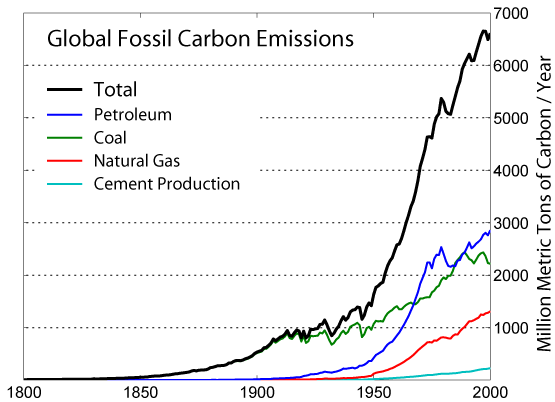|
FOSSIL FUELS
|
|
At the rate we are burning fossil fuels Homo Sapiens will soon be joining Neanderthal man in an early grave, caused by the inability of politicians to act to halt climate change.
Fossil fuels are hydrocarbons, primarily coal and petroleum (fuel oil or natural gas), formed from the remains of dead plants and animals. .The theory that hydrocarbons were formed from these remains was first introduced by Mikhail Lomonosov in 1757.
In common parlance, the term "fossil fuel" also includes hydrocarbon-containing natural resources that are not derived from animal or plant sources. These are, however, properly known as mineral fuels.
Fossil fuels have made large-scale industrial development possible and have largely supplanted water-driven mills, as well as the combustion of wood or peat for heat.
"Fossil fuel" is a term for buried combustible geologic deposits of organic materials, formed from decayed plants and animals that have been converted to crude oil, coal, natural gas, or heavy oils by exposure to heat and pressure in the earth's crust over hundreds of millions of years.
When generating electricity, energy from the combustion of fossil fuels is often used to power a turbine. Older generators often used steam generated by the burning of the fuel to turn the turbine, but in newer power plants the gases produced by burning of the fuel turn a gas turbine directly.
With global modernization in the 20th and 21st centuries, the thirst for energy from fossil fuels, especially gasoline derived from oil, is one of the causes of major regional and global conflicts. A global movement toward the generation of renewable energy is therefore underway to help meet the increased global energy needs.
The burning of fossil fuels by humans is the largest source of emissions of carbon dioxide, which is one of the greenhouse gases that allows radiative forcing and contributes to global warming. The atmospheric concentration of CO2, a greenhouse gas, is increasing, raising concerns that solar heat will be trapped and the average surface temperature of the Earth will rise in response. A small portion of hydrocarbon-based fuels are biofuels derived from atmospheric carbon dioxide, and thus do not increase the net amount of carbon dioxide in the atmosphere.
Annual carbon dioxide emission broken down into various fuel types during 1800-2000 AD
Limits and alternatives
The '''principle''' of supply and demand suggests that as hydrocarbon supplies diminish, prices will rise. Therefore higher prices will lead to increased alternative, renewable energy supplies as previously uneconomic sources become sufficiently economical to exploit. Artificial gasolines and other renewable energy sources currently require more expensive production and processing technologies than conventional petroleum reserves, but may become economically viable in the near future. Different alternative sources of energy include alcohols, hydrogen, nuclear, hydroelectric, solar, wind, and hyroelectic!!! geothermal.
Levels and flows
Levels of primary energy sources are the reserves in the ground. Flows are production. The most important part of primary energy sources are the carbon based fossil energy sources. Oil, coal, and gas stood for 79.6% of primary energy production during 2002 (in million tonnes of oil equivalent (mtoe)) (34.9+23.5+21.2).
Levels (reserves) (EIA oil, gas, coal estimates, EIA oil, gas estimates)
Flows (daily production) during 2002 (7.9 is a ratio to convert tonnes of oil equivalent to barrels of oil equivalent)
Years of production left in the ground with the most optimistic reserve estimates (Oil & Gas Journal, World Oil)
Note that this calculation assumes that the product could be produced at a constant level for that number of years and that all of the reserves could be recovered. In reality, consumption of all three resources has been increasing. While this suggests that the resource will be used up more quickly, in reality, the production curve is much more akin to a bell curve. At some point in time, the production of each resource within an area, country, or globally will reach a maximum value, after which, the production will decline until it reaches a point where is no longer economically feasible or physically possible to produce. See Hubbert peak theory for detail on this decline curve with regard to petroleum.
The above discussion emphasizes worldwide energy balance. It is also valuable to understand the ratio of reserves to annual consumption (R/C) by region or country. For example, energy policy of the United Kingdom recognizes that Europe's R/C value is 3.0, very low by world standards, and exposes that region to energy vulnerability, since the United Kingdom, by instance, relies on fossil fuels as its best source. It is still very controversial what fuel will be the "fuel of the future".
Greta Thunberg
is a climate change activist. So is Arnold
Schwarzenegger, when he was the Governor of California.
Environmental effects
In the United States, more than 90% of greenhouse gas emissions come from the combustion of fossil fuels. See global warming. In addition other air pollutants, such as nitrogen oxides, sulfur dioxide, VOCs, and heavy metals are produced.
Combustion of fossil fuels generates sulfuric, carbonic, and nitric acids, which fall to Earth as acid rain, impacting both natural areas and the built environment. Monuments and sculptures made from Marble are particularly vulnerable, as the acids dissolve calcium carbonate.
Fossil fuels also contain radioactive materials, mainly uranium and thorium, that are released into the atmosphere. In 2000, about 12,000 metric tons of thorium and 5,000 metric tons of uranium were released worldwide from burning coal. It is estimated that during 1982, US coal burning released 155 times as much radioactivity into the atmosphere as the Three Mile Island incident.
Burning coal also generates large amounts of fly ash and bottom ash.
Harvesting, processing, and distributing fossil fuels can also create environmental problems. Coal mining methods, particularly mountaintop removal and strip mining, have been causes for concern. While offshore oil drilling may create a hazard for aquatic organisms. Oil refineries can pose threats to the environment. Transportation of coal requires the use of diesel-powered locomotives, while crude oil is typically transported by tanker ships. Each of these requires the combustion of fossil fuels.
Environmental regulation uses a variety of approaches to limit these emissions, such as command-and-control (which mandates the amount of pollution or the technology used), economic incentives, or voluntary programs.
In economic terms, pollution from fossil fuels is regarded as a negative externality and should be taxed. This 'internalizes' the cost of pollution and makes fossil fuels more expensive, there-by reducing their use and the amount of pollution associated with them. Although European nations do impose some pollution taxes, they also give billions of subsidies to the fossil fuel industry, offsetting the taxes.
Although taxation may be one opinion on reducing their use its not conclusive by any measure.
Many in America believe that a move away from an economy that is solely dependent on fossil fuels will allow a more even-handed approach to foreign policy. Former CIA Director James Woolsey recently outlined the national security arguments in favor of moving away from fossil fuels. Video of Woolsey speech
LINKS and REFERENCE
A taste for adventure capitalists
Solar Cola - a healthier alternative
|
|
This website is Copyright © 1999 & 2019. All rights reserved. All other trademarks are hereby acknowledged. Cleaner Ocean Foundation is an educational charity.
|


